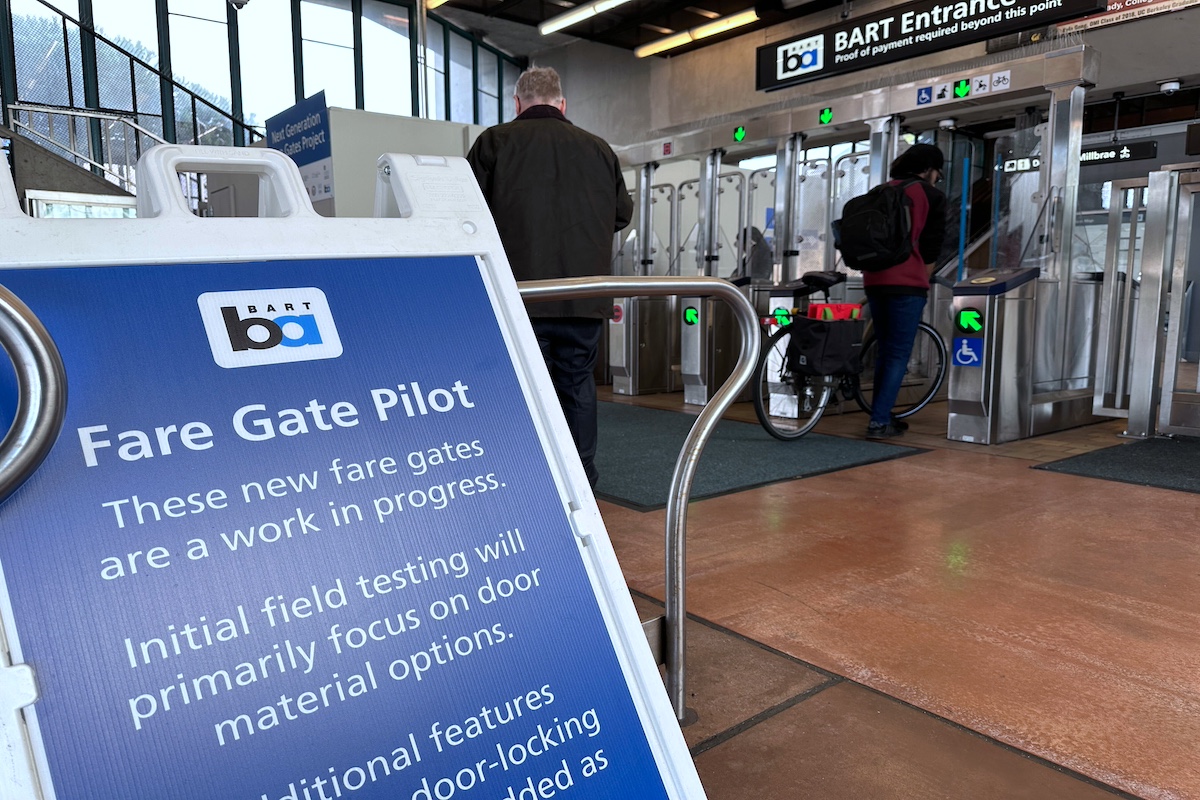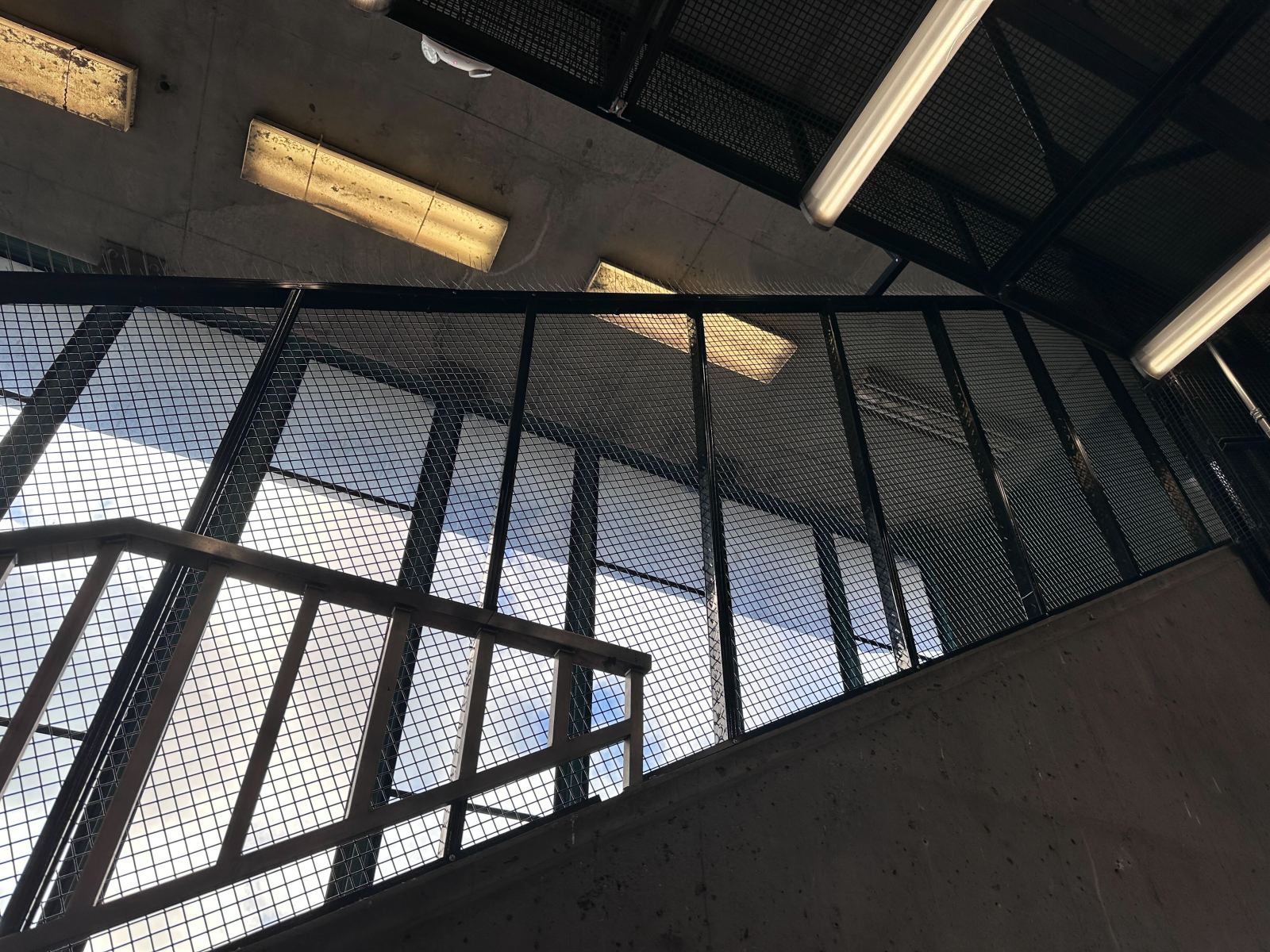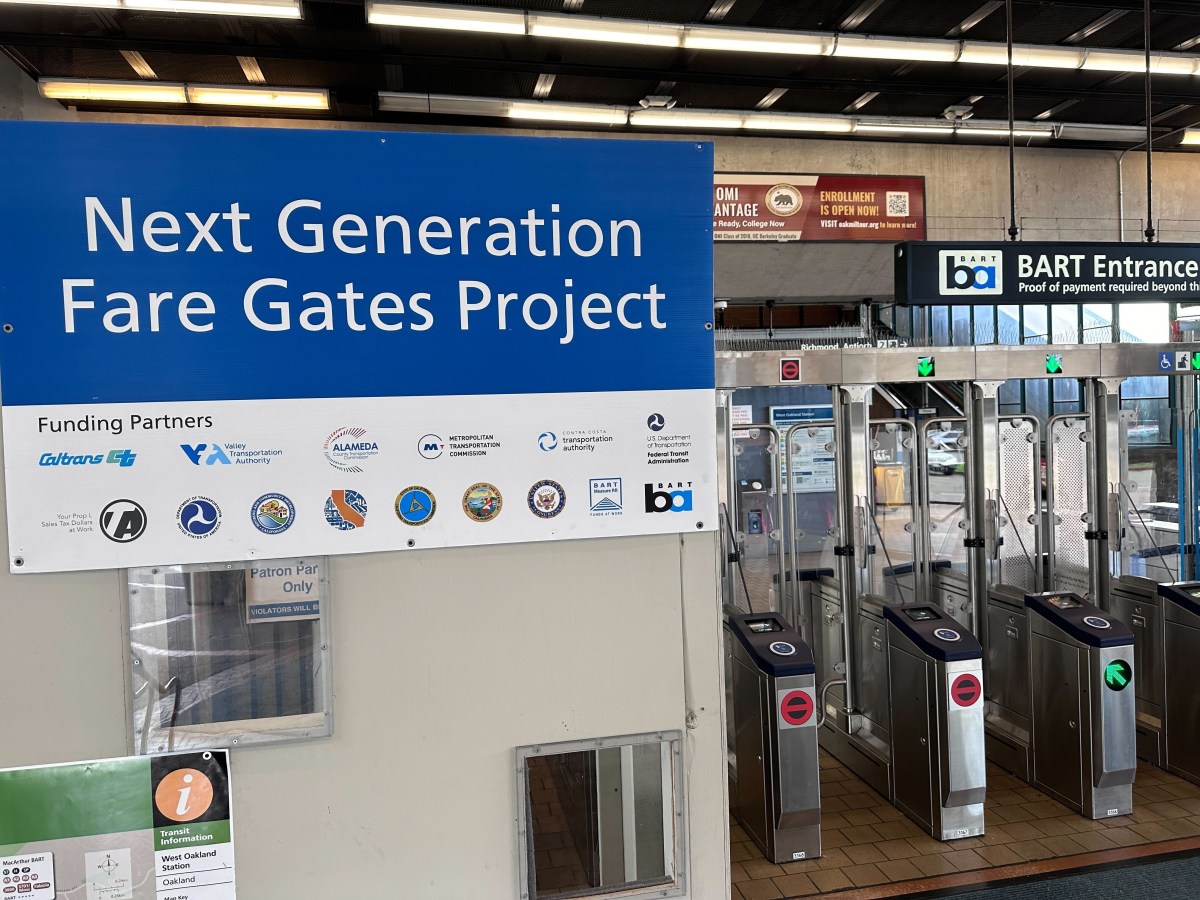Taller, heavier entry gates might not create a foolproof system to prevent fare evasion, but the new gates at the West Oakland BART Station might be more effective than the gates BART currently uses across its other stations.
At least, that’s what more than a dozen people told The Oaklandside on Tuesday at the station, where the new gates were installed on Dec. 28, part of a pilot program by BART to “harden” the train system so that it’s more difficult for people who don’t pay to get in and board a train.
The installation at West Oakland features three prototypes for gate doors that look imposing but aren’t much different from what you’d see in other big-city train stations, like New York City or Paris.
All three of the new gate prototypes have polycarbonate hard plastic see-through doors. All the doors open away from the person entering or leaving the station, like saloon doors, and they are much taller than the BART fare gates used in all the other stations currently. The short height of BART’s existing fare gates makes jumping over them easy. The top of the new gates also features metal spikes to dissuade people from trying to climb over.
“I think they’ll do the job for people jumping over them, but I can see—and have seen—people ram through the new gates already with their shoulders,” said one man who came out of the West Oakland train station and spoke with us.
BART plans to implement a new mechanical lock for the doors, supposedly making it harder for people to push through and open the gate.
Currently, the plastic doors’ resistance when someone is pushing against them without having paid is managed through software but the lock motor fails if there’s enough force, putting into safe mode. It’s still relatively hard to push through, although it is possible, as The Oaklandside observed.
At one point, a person tried to pry open the doors from inside to leave the station. Unable to do so, she yelled to the station attendant to help her. When another person tagged their Clipper Card to exit, the woman held onto one of the doors and was able to squeeze out. That practice is commonly known as “piggybacking,” and it frequently happens at BART stations equipped with the traditional type of fare gates.
BART currently doesn’t have any data about which of the three different door systems performs best at reducing fare evasion, according to BART Communications Director Alicia Trost. However, The new gates can tell how many people are tagging their Clipper Cards and how many pass through without tagging.
“We will start measuring that shortly, but we don’t have any of that data yet, nor do we have a baseline figure to compare it to,” Trost said. She also noted that the new gates can’t count how many people evade their fare by using the emergency swing gates, which are now noticeably shorter than the new gates.
BART has said previously that evasion costs the system between $15-25 million annually. The agency plans to install new fare gates in all stations by the end of 2025 at a total cost of $90 million. Once BART determines which of the three prototypes is the best, they will continue adding new gates.

Trost said one issue they’ve seen already in West Oakland is that the doors tend to lag about 1.2 seconds from when riders tag their Clipper card or phone to when the doors open. This has led to West Oakland riders complaining online and at the station that the gates are causing unnecessary delays during rush hour traffic. We spoke to two people this week who said that the lag has actually extended a few times to three seconds for them, causing them to miss their train.
“The new fare gates have the exact same card reader as all other fare gates at BART, but the communication between the reader and the new gate is new. We hope to have a fix in the coming weeks,” Trost told The Oaklandside.
“I think the gate delay has gotten better in the last week, but it’s definitely slow,” Jade P., an Antioch resident who takes the BART to her job in San Francisco, told us this week. Tagging the old fare gates usually opens them immediately or in less than half a second.
The gates were created by South Korean vendor STraffic with installation and management by BART hardware and software engineers.
New features on the gates allow people to pay for their fare directly through Apple Pay by swiping or hovering their phones above the gate sensor. This allows people to avoid waiting in a queue to add money to their Clipper card. The BART team is also working on making the gates louder when they open, with a more distinctive sound that is supposed to make it easier for the visually impaired to know when it’s safe to pass through.
Eight stations will receive the new gates next, although only one of them, the Fruitvale BART station, is in Oakland. The other ones will be at the Civic Center, Montgomery, Powell, 24th Street stations, SFO airport stations in San Francisco, and the Richmond and Antioch stations in the East Bay.
What do BART riders have to say so far about the new fare gates?

Almost every BART rider we spoke to said that the height and security of the gates might end the problem of jumping over the turnstiles. But they said they’ve seen people continue to push through or piggyback their way into the station.
Jade from Antioch said she had already seen people piggybacking easily behind paying customers. She said that spending $90 million on an upgrade of the gate system is not worth it.
“It’s ridiculous,” she said. “There are much bigger issues that are problems in the BART. People are urinating inside the trains.” Jade thought the money could have been used to hire more people to clean and serve as security, or it could have been given to local homeless housing programs, making them less likely to use the system as a second or only home.
A couple using the new fare gates for the first time, Jack Connors and Saph Matzke, told us it showcased the need for an entirely free transit system. They said that many people using BART are low-income and that the cost of cracking down on fare evaders isn’t worth the trouble.
According to BART’s latest operating financial outlook documents, part of the reason why it has struggled financially is because of the precipitous fall in revenues from ridership fares. Before the pandemic, in 2019, fare gates paid for 66% of the system’s operating expenses or about $520 million annually. During the peak of the pandemic, revenues fell to $69 million, or 9% of operating expenses. Even with ridership growing again, fiscal year 2024 revenues are only expected to reach $298 million.
Alonzo Floyd, a Vallejo resident who takes BART from West Oakland to his San Francisco job daily, told us that in the 15 work days, he’s gone through the gates, he’s seen close to eight people piggyback or push their way through the gates without paying. But he said that he worries more about the gates making it harder for children or others to go through, as they may get stuck, suffer injuries, and eventually sue the system, putting it in an even more dire financial position than it currently is.
“We’re sue-happy in California, and just for that, it may not be worth it,” he said.
Floyd also said that while waiting on the platforms at the West Oakland station, he didn’t see as many young teens waiting on trains as there used to be in the past. He said he believes, based on his personal observations, that some of these youngsters have been involved in petty thefts in the past.
During the launch of the gates last month, there was discussion among locals online that the new gates would make the whole system safer to ride by reducing crime. The thinking went that most people committing crimes on the BART platforms and trains were being committed by the same people jumping over gates.

Jontae Harrison, a local rap artist and Oakland resident, said that he wasn’t sure whether fare gate evasion was connected to crime on the BART system but he agreed with the notion that making it safer to ride the trains in peace is critical to bringing back riders. He told us that he had just seen a person on the train smoke crack and was worried about smelling it inside one of the trains.
“To be honest, the [fare gates] are a waste of time. There are lots of things that need to be [improved], but the crack, the weed, that’s in the system. I wish they would reduce that,” Harrison said.
Oakland resident Joshua Davis, who is a software engineer, said on Twitter that he has started riding Uber and AC Transit more since the gates went up because there was one gate available for bikes, wheelchairs, and other bulky items. In the past, many cyclists picked up their bikes and held it over any of the multiple turnstiles as they scanned their fare.
“It’s just not worth the hassle of having only 1 gate for bikes, maybe missing my train because of a queue, and then having to wait 20 minutes for the next train, he wrote. “BART is a 19-minute walk for me, the feeder bus only comes every 20 minutes and I don’t own a car so biking is the best option.”
Trost told The Oaklandside that they’ve received “all sorts of comments” from people, including many who have not yet tried the gates.
More importantly, she said that BART currently is not measuring the success of the gates through the number of paid exits but instead by the full completion of the project at each station and by comparing the reliability of the old gates to the new ones. They’ve already noticed people who have evaded fares at other stations get to the West Oakland station and turn around, to “likely fare evade at the next station.

